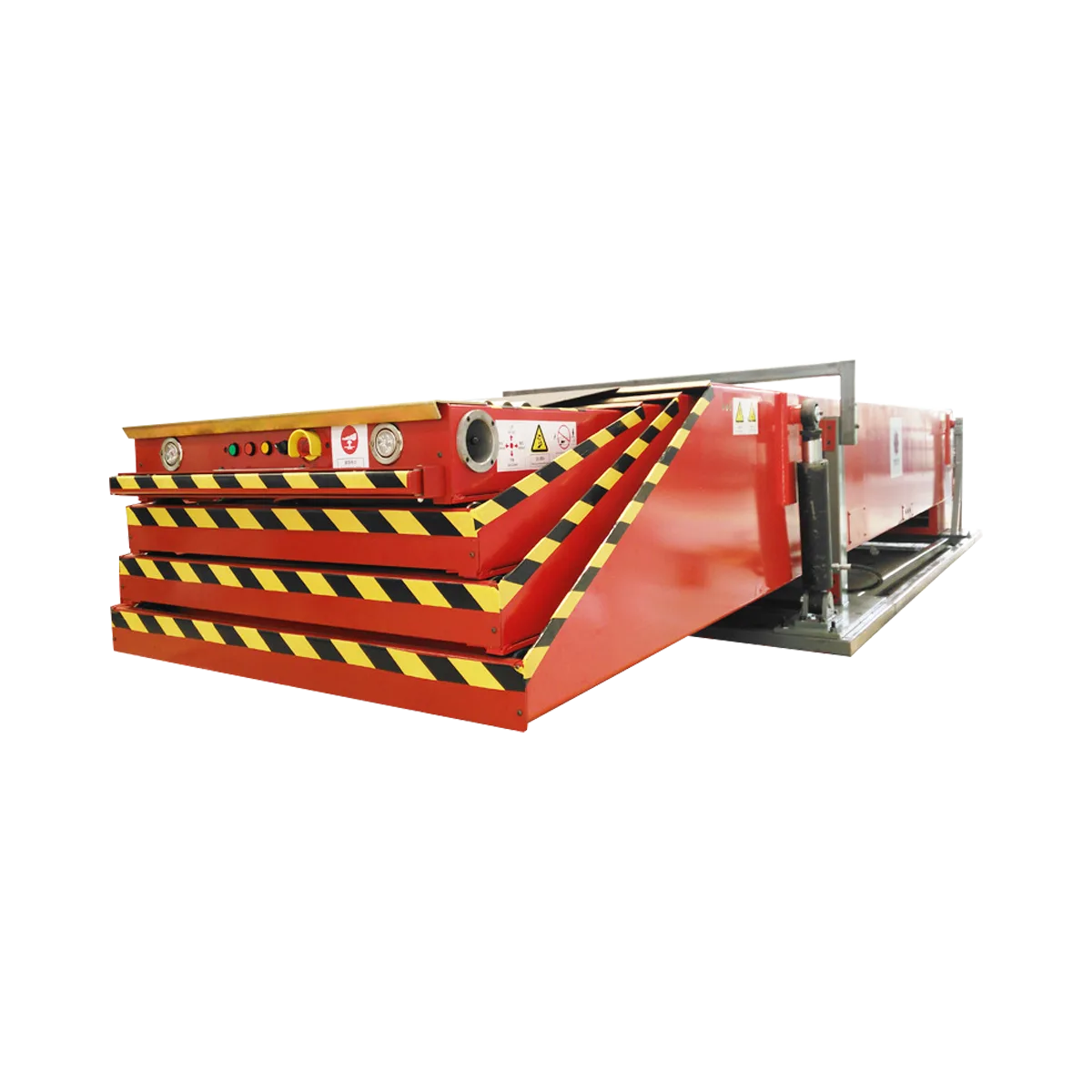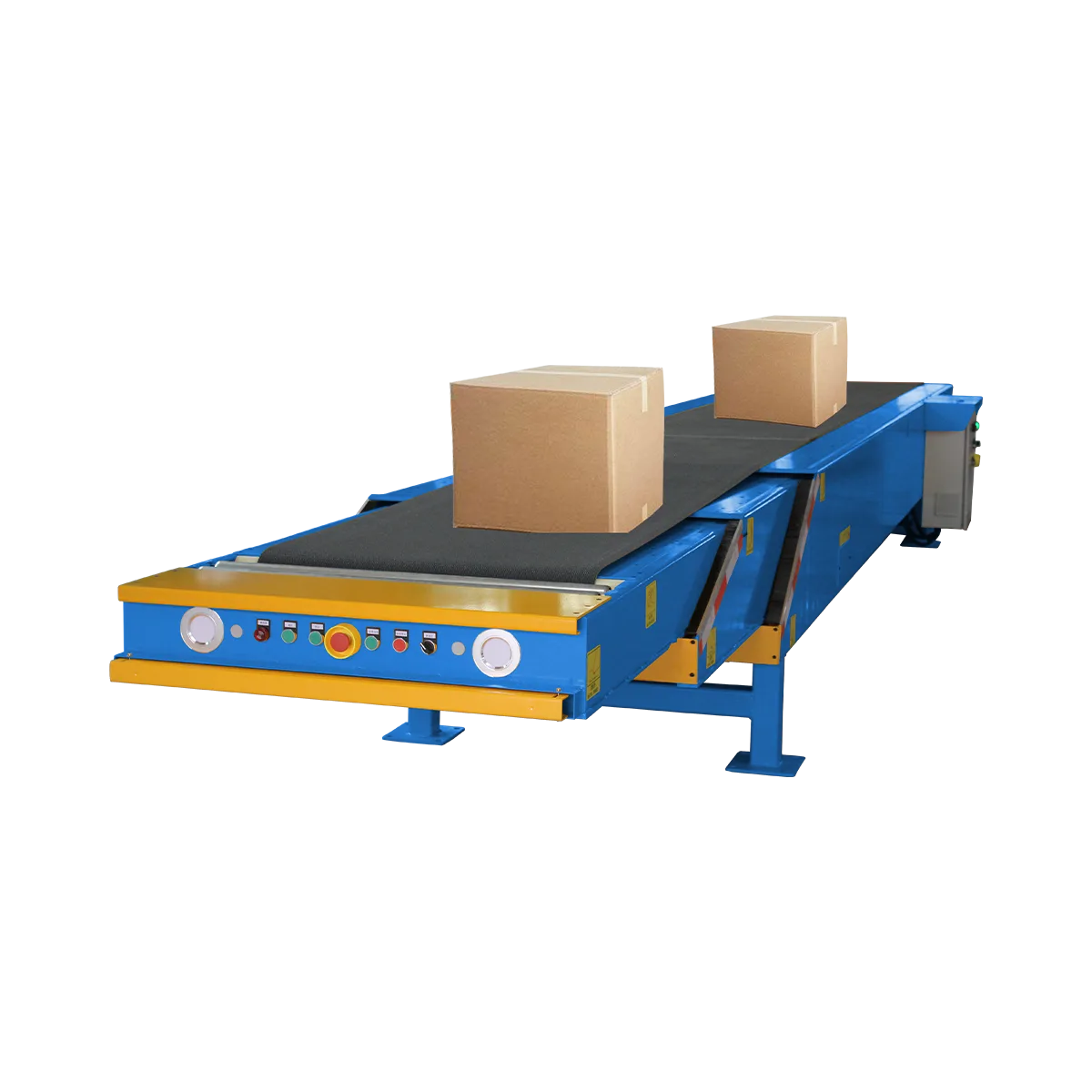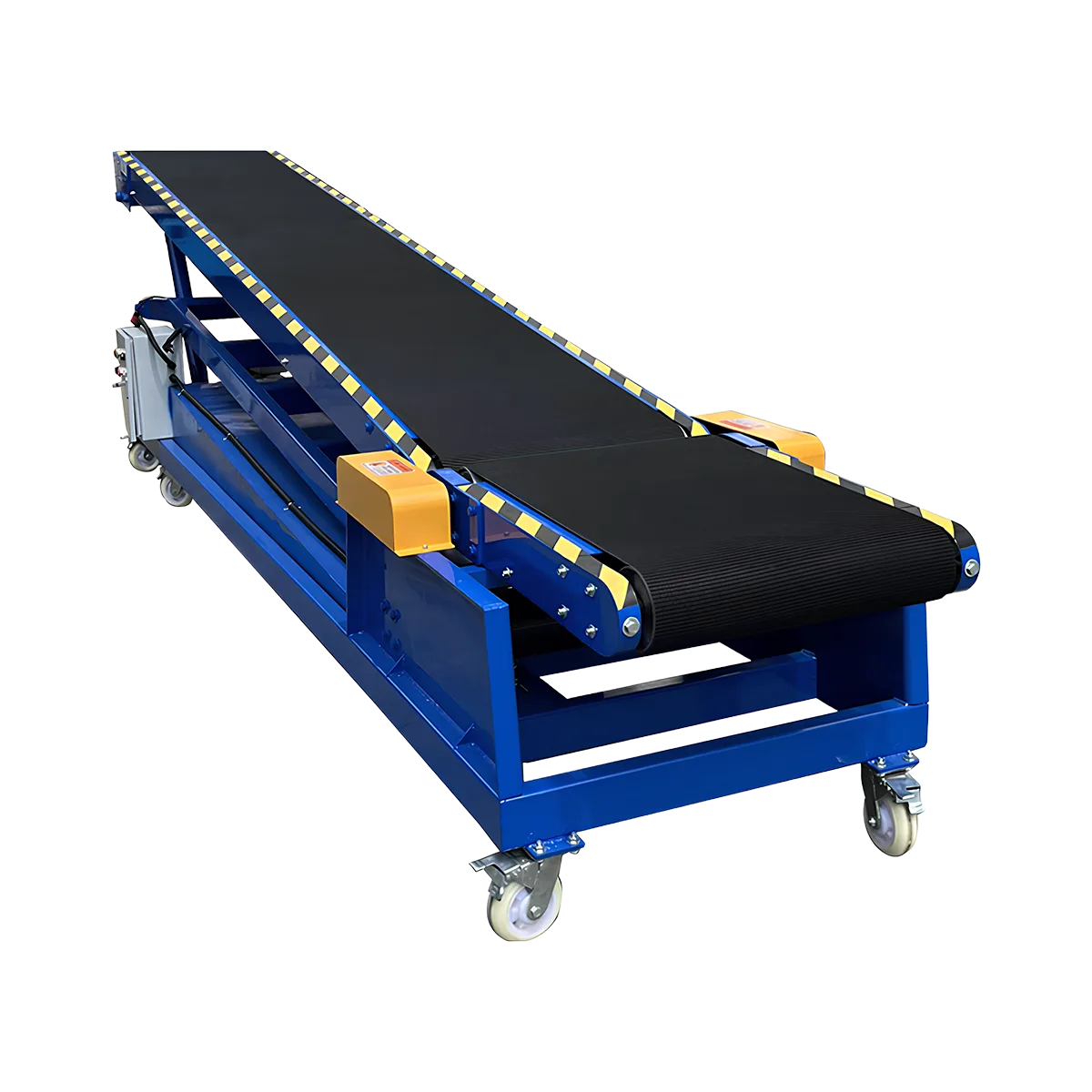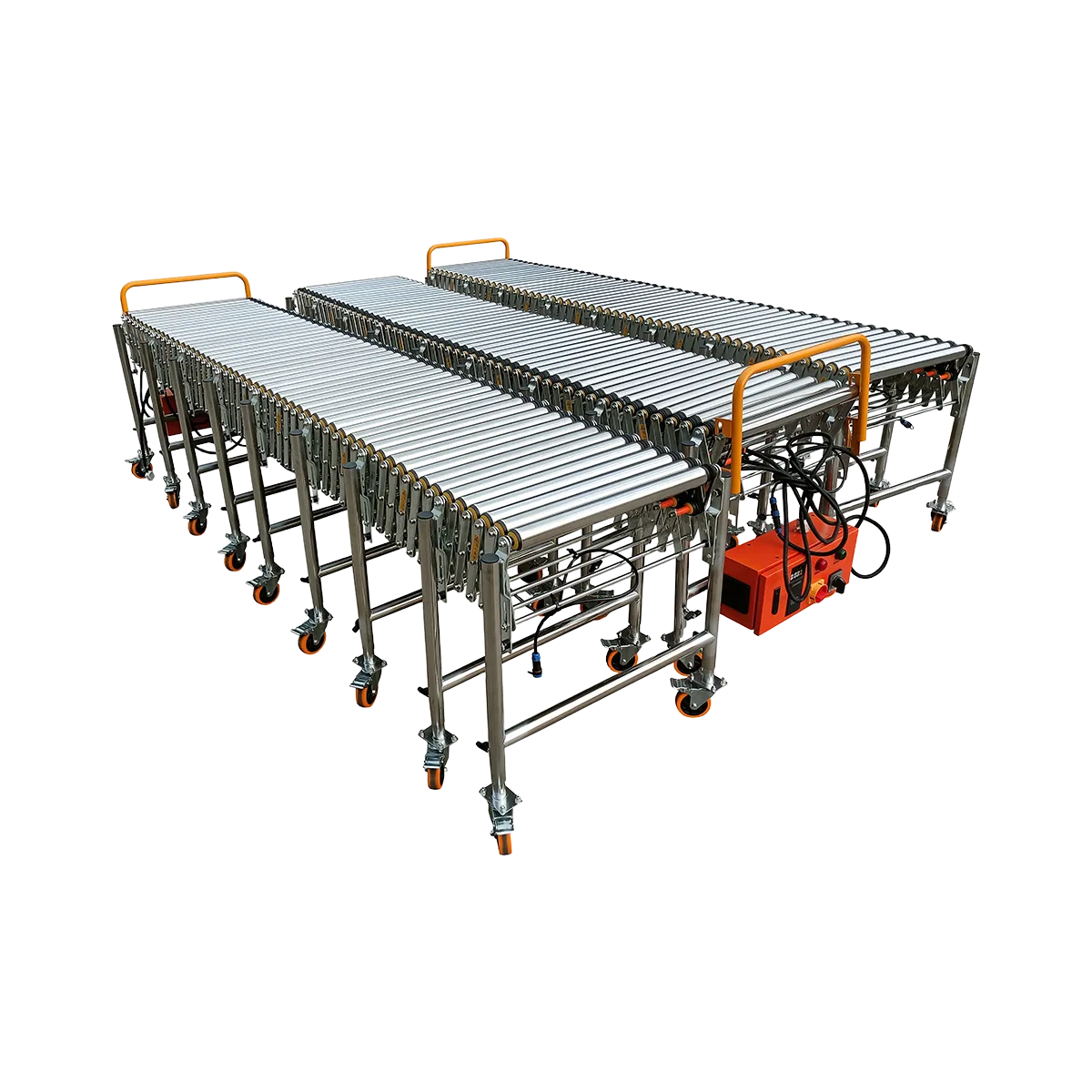Solving the Last 50 Feet: Connecting Fixed Conveyor Systems to Loading Docks
Discover effective solutions for conveyor system integration between fixed sorters and loading docks. Bridge the automation gap with flexible, mobile conveyor systems for seamless logistics.
Related Products
-
TeleScopic Conveyor – 4 SectionsCollapsed LengthExtended LengthLoad Capacity
60 kg/m
Applicable GoodsFlat-bottomed Goods
Bagged Goods
-
TeleScopic Conveyor – 3 SectionsCollapsed LengthExtended LengthLoad Capacity
60 kg/m
Applicable GoodsFlat-bottomed Goods
Bagged Goods
-
Hydraulic Conveyor – Medium – 7000 mm LengthCollapsed LengthExtended LengthLoad Capacity
80 kg/m
Applicable GoodsFlat-bottomed Goods
Bagged Goods
-
Powered Roller Conveyor – Multi-wedge Belt Driven – 2000 mm/SectionCollapsed Length
700 mm
Extended Length2000 mm
Load Capacity100 kg/m
Applicable GoodsFlat-bottomed Goods
-
Powered Roller Conveyor – Multi-wedge Belt Driven – 3000 mm/SectionCollapsed Length
1050 mm
Extended Length3000 mm
Load Capacity80 kg/m
Applicable GoodsFlat-bottomed Goods
The modern warehouse automation revolution has transformed the bulk of material handling operations, with high-speed sorters and fixed conveyor systems moving packages efficiently throughout facilities. However, many operations face a critical challenge in the final connection point – the last 50 feet between fixed conveyor systems and loading docks. This conveyor system integration gap often becomes a bottleneck where automated efficiency meets manual handling, creating delays, increasing labor costs, and risking product damage. Solving this connection challenge requires specialized flexible solutions that can bridge fixed systems with the dynamic environment of loading and unloading areas.
The Integration Challenge
The Fixed-End Problem
Fixed conveyor systems excel at moving products efficiently within predetermined paths, but they face significant limitations when connecting to loading areas:
- Inflexibility: Permanent conveyors cannot adjust to varying truck heights, positions, or depths
- Space constraints: Fixed systems cannot extend into varying truck positions or be removed when not in use
- Adaptation issues: Standard conveyors struggle to interface with the constantly changing environment of a loading dock
- Installation complexity: Extending fixed systems to multiple dock doors requires substantial investment and construction
These limitations create a critical gap in the warehouse automation chain, forcing many operations to resort to manual handling for the final loading and unloading processes, which significantly reduces overall efficiency.
The Need for Flexible Transitions
Creating an effective dock to sorter connection requires equipment that can address several key requirements:
- Mobility: Systems that can move between dock doors as needed
- Height adjustability: Ability to match varying truck bed heights
- Length adaptability: Extending reach into trucks of different depths
- Integration capability: Seamless connection with existing fixed conveyor systems
- Operational flexibility: Supporting both loading and unloading operations
Without addressing these requirements, warehouses experience inefficiencies that impact throughput, increase labor costs, and potentially damage products through excessive manual handling.
The Bridge Solution
Creating an effective loading dock extension requires a combination of different conveyor technologies that work together as a comprehensive flexible end of line solution. Based on our analysis of various warehouse configurations, we recommend a modular approach using complementary systems.
Primary Connection: Powered Roller Systems
Powered Roller Conveyor systems provide the ideal primary connection between fixed conveyors and the loading area for several reasons:
- Power-driven operation: Ensures consistent package movement regardless of weight or surface
- Bidirectional capability: Supports both loading and unloading operations
- Adjustable speed: Can be synchronized with existing fixed systems
- Modular expandability: Multiple sections can be connected to create custom lengths
- Height adjustability: Support legs can be adjusted to match existing conveyor heights
The most effective configuration uses Powered Roller Conveyors with multi-wedge belt drive in 2000mm sections, providing 100 kg/m capacity – sufficient for most loading dock applications. For operations handling lighter packages, the O-belt driven 1500mm sections offer a more economical alternative.
Final Reach: Flexible Gravity Solutions
For the final extension into truck trailers, gravity-based systems offer superior flexibility:
- Gravity Roller Conveyors: For heavier items and more stable movement
- Gravity Skate Wheel Conveyors: For maximum extension capability and lighter packages
The Gravity Skate Wheel Conveyor with its 1:5 extension ratio (extending from 420mm to 2100mm) provides exceptional reach while minimizing storage space when not in use. For heavier items, the 50mm diameter Gravity Roller Conveyor offers superior weight capacity at 50 kg/m.
These gravity systems can be positioned at a slight decline to facilitate smooth product movement into the trailer without requiring power at the furthest extension point.
Specialized Solutions for Height Challenges
For facilities without standard loading docks or dealing with significant height variations, two specialized options are available:
- Hydraulic Conveyor Systems: These provide powered height adjustment and incline capabilities, with models like the Medium (7000mm) able to transition from ground level to trailer height.
- Powered Rubber Roller Conveyors: These provide superior grip for inclined operations, with the multi-wedge belt driven model offering reliable package movement on slopes.
It’s important to note that Telescopic Conveyors, while excellent for deep reach applications, are not typically integrated with Hydraulic Conveyors due to compatibility limitations.
Installation and Integration Guide
Connection with Fixed Systems
Successful warehouse automation bridge implementation requires careful planning of the interface between fixed and mobile systems:
- Matching heights: Ensure the powered roller section height aligns precisely with the fixed conveyor output height
- Transition smoothing: Install transition plates between different conveyor types to eliminate gaps
- Speed synchronization: Set the powered section speed to match or slightly exceed the fixed system
- Power access: Plan for convenient power connection points near dock doors
- Control integration: Consider whether independent controls or integration with the main system is preferred
Creating a Smooth Transition Chain
For optimal performance, we recommend a specific sequence of components:
- Fixed end: Begin with a short powered section (1.5-2m) directly connected to the fixed system
- Middle bridge: Add powered sections with appropriate length to reach the dock edge
- Flexible end: Finish with gravity sections that can extend into the trailer
This configuration creates a balanced system that maintains powered control where needed while providing the flexibility required at the trailer interface.
Typical Configuration Example:
| Position | Recommended Equipment | Length | Key Function |
|---|---|---|---|
| Fixed connection | Powered Roller Conveyor (Multi-wedge) | 2000mm | Transition from fixed system |
| Mobile bridge | Powered Roller Conveyor (O-belt) | 3000mm (2 sections) | Movable powered transport |
| Truck reach | Gravity Skate Wheel Conveyor | 2100mm (extended) | Flexible final extension |
Operational Considerations
To maximize the effectiveness of your loading dock extension:
- Position the system at a slight angle for gravity flow in the desired direction
- Use locking casters to secure the system during operation
- Implement standardized procedures for extension and retraction
- Train operators on proper handling and position adjustment
- Establish regular maintenance schedules for all components
Conclusion
Implementing an effective bridge between fixed conveyor systems and loading docks eliminates one of the most persistent bottlenecks in warehouse operations. By creating a flexible, mobile connection point, operations can extend automation benefits all the way to the trailer door, completing the automation chain with the right final link.
The key to success lies in selecting the appropriate combination of powered and gravity systems that match your specific operational requirements. With proper implementation, warehouses can expect:
- Reduced labor requirements at loading points
- Decreased product damage from manual handling
- Increased throughput capacity
- Improved worker safety and ergonomics
- Enhanced overall system efficiency
By solving the last 50 feet challenge, operations can finally achieve true end-to-end automation, maximizing the return on their conveyor system investments while improving operational performance.
Frequently Asked Questions
How many staff are needed to operate these flexible conveyor systems?
Typically, operations require two staff members – one at the loading point and one at the unloading end. This represents a significant reduction compared to fully manual loading operations.
What is the typical ROI period for implementing a flexible dock connection system?
Most operations see a return on investment within 12-18 months, depending on throughput volume and current labor costs for manual loading/unloading.
Can these systems work with varying truck bed heights?
Yes. The support legs on standard conveyor sections are height-adjustable, while Hydraulic Conveyor systems offer powered height adjustment with ranges up to 1700mm.
What maintenance is required for these flexible conveyor systems?
Maintenance requirements are minimal. Powered sections need belt tension checks and bearing lubrication quarterly, while gravity sections primarily require bearing checks and occasional cleaning.
How quickly can these systems be moved between loading docks?
With proper caster configurations, two staff members can typically relocate a complete system between adjacent dock doors in 3-5 minutes, allowing for flexible allocation of loading resources.
Table of Contents
Recent Posts
Master seasonal warehouse solutions with our peak season logistics guide. Learn how to expand loading capacity, manage high volumes, and implement flexible systems when you need them most.
Discover the most efficient frozen goods conveyor system for loading refrigerated trucks while maintaining cold chain integrity at your cold storage warehouse.
Optimize your wholesale club logistics with heavy-duty roller conveyor systems designed for bulk goods handling. Improve efficiency in Costco style warehouses with our solutions.
Optimize tire handling in automotive logistics with specialized conveyor for tires that provides superior grip and controlled movement, minimizing manual handling and increasing efficiency.




